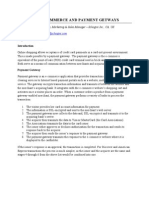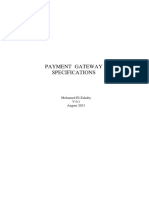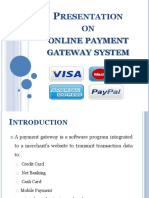0% found this document useful (0 votes)
36 views2 pagesPayment Gateway Workflow
The document outlines the 12 steps in an online payment transaction process: 1) A customer initiates a purchase on a merchant's website. 2) The payment gateway receives and encrypts the transaction details for security. 3) The gateway forwards the encrypted details to the acquiring bank which sends an authorization request to the card network. 4) The card network validates details and checks funds, sending the authorization response back to the acquiring bank through the gateway. 5) The gateway relays the authorization status to the merchant who can then fulfill the order if approved.
Uploaded by
Sugam Kant GargCopyright
© © All Rights Reserved
We take content rights seriously. If you suspect this is your content, claim it here.
Available Formats
Download as DOCX, PDF, TXT or read online on Scribd
0% found this document useful (0 votes)
36 views2 pagesPayment Gateway Workflow
The document outlines the 12 steps in an online payment transaction process: 1) A customer initiates a purchase on a merchant's website. 2) The payment gateway receives and encrypts the transaction details for security. 3) The gateway forwards the encrypted details to the acquiring bank which sends an authorization request to the card network. 4) The card network validates details and checks funds, sending the authorization response back to the acquiring bank through the gateway. 5) The gateway relays the authorization status to the merchant who can then fulfill the order if approved.
Uploaded by
Sugam Kant GargCopyright
© © All Rights Reserved
We take content rights seriously. If you suspect this is your content, claim it here.
Available Formats
Download as DOCX, PDF, TXT or read online on Scribd
/ 2
























































